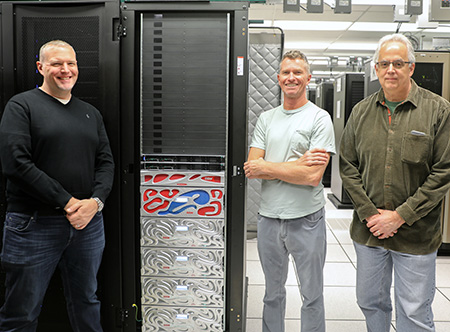Campus News
Powerful new supercomputer supports campus research in physical sciences
UCSC faculty are using the new system for research in astrophysics, climate science, materials science, chemistry, and other fields.


A new supercomputer at UC Santa Cruz is providing a state-of-the-art high-performance computing system for researchers in a wide range of fields. The new system, called lux, is substantially more powerful than previous campus supercomputers and was designed with the latest technologies to enable advanced computational studies in areas such as climate modeling, astrophysical simulations, and machine learning.
“I’m excited about leveraging these new technologies to do computational studies we weren’t able to do before at UC Santa Cruz,” said Brant Robertson, associate professor of astronomy and astrophysics.
Robertson led a team of 20 UCSC faculty members from six departments to put together a proposal for the project, which won a $1.5 million grant from the National Science Foundation’s Major Research Instrumentation program. The team includes faculty in the Departments of Astronomy & Astrophysics, Chemistry & Biochemistry, Earth and Planetary Sciences, Physics, Applied Mathematics, and Computer Science & Engineering.
High-performance computing has become an increasingly important tool for researchers throughout the physical sciences. Sophisticated computer simulations can be used to model extremely complex phenomena, from the behavior of Earth’s climate system to the evolution of galaxies. In addition, scientists in a growing number of fields are applying the computationally intensive techniques of machine learning to problems involving large datasets.
“In astronomy, we are just starting to deploy deep learning at large scale. When we are able to automate the analysis of astronomical images from large surveys, it will revolutionize how we do astronomy,” Robertson said.
Although researchers may have access to much bigger supercomputers than lux at national computing facilities operated by the National Science Foundation and the Department of Energy, Robertson said it is crucial for UC Santa Cruz to have its own local system.
“If you want to develop code to run on the largest supercomputer in the world, you need to have a local system that has the same high-end components. We designed lux so that it can serve as a springboard for our researchers to get time on the national systems,” he said.
Lux is also important for training students in the latest computational techniques. It will be available to students in advanced computational courses and programs such as the Lamat program in computational astrophysics, as well as visiting scientists and participants in summer programs.
Robertson said there are already about 100 different accounts on the lux system. “People are up and running on it,” he said.